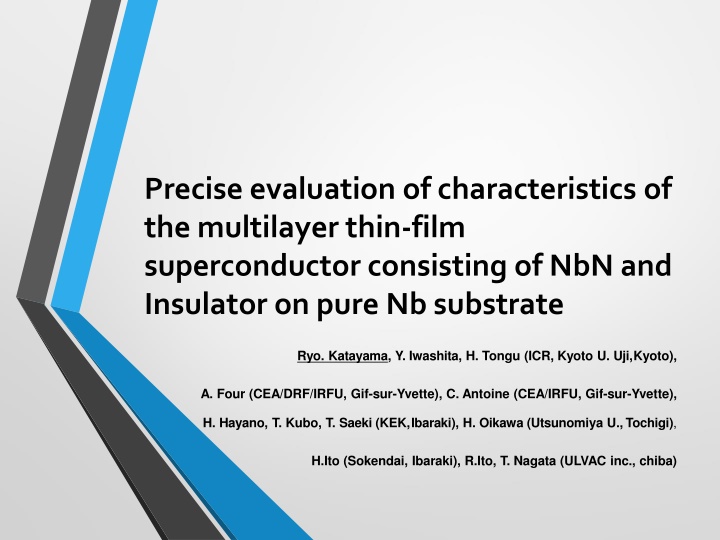
Precise Evaluation of Characteristics of Multilayer Thin-Film Superconductor
Explore the precise evaluation of characteristics of a multilayer thin-film superconductor consisting of NbN and insulator on a pure Nb substrate. The study focuses on improving the effective Hc1 to enhance the maximum accelerating gradient of superconducting cavities. Experimental results show a 17% improvement in effective Hc1. Measurement methods, results, and the motivation behind the study are discussed, providing valuable insights into superconductor performance.
Download Presentation

Please find below an Image/Link to download the presentation.
The content on the website is provided AS IS for your information and personal use only. It may not be sold, licensed, or shared on other websites without obtaining consent from the author. If you encounter any issues during the download, it is possible that the publisher has removed the file from their server.
You are allowed to download the files provided on this website for personal or commercial use, subject to the condition that they are used lawfully. All files are the property of their respective owners.
The content on the website is provided AS IS for your information and personal use only. It may not be sold, licensed, or shared on other websites without obtaining consent from the author.
E N D
Presentation Transcript
Precise evaluation of characteristics of the multilayer thin-film superconductor consisting of NbN and Insulator on pure Nb substrate Ryo. Katayama, Y. Iwashita, H. Tongu (ICR, Kyoto U. Uji,Kyoto), A. Four (CEA/DRF/IRFU, Gif-sur-Yvette), C. Antoine (CEA/IRFU, Gif-sur-Yvette), H. Hayano, T. Kubo, T. Saeki (KEK,Ibaraki), H. Oikawa (Utsunomiya U.,Tochigi), H.Ito (Sokendai, Ibaraki), R.Ito, T. Nagata (ULVAC inc., chiba)
Outline Introduction Measurement method Experimental Result Experiment result shows that the effective Hc1, which limits the maximum accelerating gradient of superconducting cavities, is improved by about 17 %. Summary 8 8.2 8.4 8.6 8.8 0.05 Effective Hc1 [Tesla] NbN/SiO2/Nb sample NbN/SiO2/Nb sample 0.045 Nb-Bulk Sample Bulk NbSample 0.04 0.035 Fitting Curve (Nb) 0.18 (1-(T/9.2)2) 0.03 Fitting Curve (<9.2 K) 0.21 (1-(T/9.21)2) 0.025 0.02 0.015 0.01 0.005 0 9 9.2 9.4 9.6 9.8 Temperature [K] 10 2
Introduction The maximum accelerating gradient of superconducting cavity is limited by the magnetic field at which vortex avalanche occurs. In this study, we calls such magnetic field as effective Hc1 , Hc1. Recently proposed theory predicts that Hc1 is pushed up by Superconductor- Insulator-Superconductor structure (S-I-S structure). In order to verify this scheme, we are trying to make some experiments at Kyoto University. S-layer I-layer S-layer (Bulk Nb) 3
Motivation of this study The proposed theory predicts an optimum set of the parameters to exhibit a good performance. The Hc1 is shown in the following two contour plots. The effective Hc1 of bulk Nb is assumed to be 200 mT. 250 mT 470 mT 4
Measurement method Schematic diagram of experimental setup is shown in the left figure. AC magnetic field Hext(t) is generated by a coil close to a sample. Hext(t)=Hacsin( t) Third harmonic voltage v3(t) = V3sin (3??) induced in the coil is measured. ?0sin (??) is the current flowing in the coil. ? is the frequency of a sinusoidal drive current. If the temperature of a sample is being raised while Hac is fixed, V3suddenly rises when Hacexceeds Hc1 of a sample at a certain temperature. Can evaluate the temperature dependence of Hc1. Cooling Liquid He In this study, =5 kHz is used. NOTE: it is expected that super heating does not occur in the frequency region. 5
Measurement method The Hc1 at a certain temperature can be determined as left figure. Expected curve: Hc1(T) = Hc1(0) (1-(T/Tc)2) Hac is the amplitude of the AC field. Hc1is determined from the cross point. By repeating measurements for different combination of Hac, we can clarify the temperature dependence of Hc1. Hc1(0) can be used for the criterion to evaluate the performance of Hc1. These data points are fitted to the above expected curve. 6
S-I-S sample used in this study We prepared S-I-S sample for measuring the effective Hc1. NbN/SiO2(30 nm) thin-film is formed on pure bulk Nb substrate (Left Figure) NbN film thick are 200 nm or 50 nm. This sample is fabricated by ULVAC inc. with DC magnetron sputtering. Nbsubstrate 7
Effective Hc1 of S-I-S sample (200 nm) Expected curve: Hc1(T) = Hc1(0) (1-(T/Tc)2) the criterion to evaluate the performance of Hc1. 0.05 Effective Hc1 [Tesla] NbN/SiO2/Nb sample NbN/SiO2/Nb sample 0.045 Nb-Bulk Sample Bulk NbSample 0.04 Hc1(0)=180 mT (pure bulk Nb) 0.035 Fitting Curve (Nb) 0.18 (1-(T/9.2)2) 0.03 Hc1(0)=210 mT (S-I-S structure) Fitting Curve (<9.2 K) 0.21 (1-(T/9.21)2) 0.025 0.02 0.015 0.01 Gain Factor: 210/180 ~ 1.17 0.005 0 8 8.2 8.4 8.6 8.8 9 9.2 9.4 9.6 9.8 Temperature [K] 10 LINAC18:TUPO030 8
Effective Hc1 of S-I-S sample (50 nm) (Preliminary) (Preliminary) NbN/SiO2/Nb sample LINAC18:TUPO030 Bulk NbSample Hc1(0)=180 mT (pure bulk Nb) Fitting Curve (Nb) 0.18 (1-(T/9.2)2) Fitting Curve (<9.2 K) 0.176 (1-(T/9.21)2) Hc1(0)=176 16 mT (S-I-S structure) No difference! The obtained results are qualitatively consistent with the prediction of theory! 9
Summary We evaluated the temperature dependence of effective Hc1 of multi-layer thin-film sample that consists of NbN superconducting layer and SiO2 insulating layer formed on pure bulk Nb. The measurement result clearly showed that the effective Hc1 of pure bulk Nb improved after NbN/SiO2 film coating, whereas effective Hc1 changed depending on the film thickness. We could successfully demonstrate that the S-I-S structure can improve the effective Hc1 by 17 %. 10
